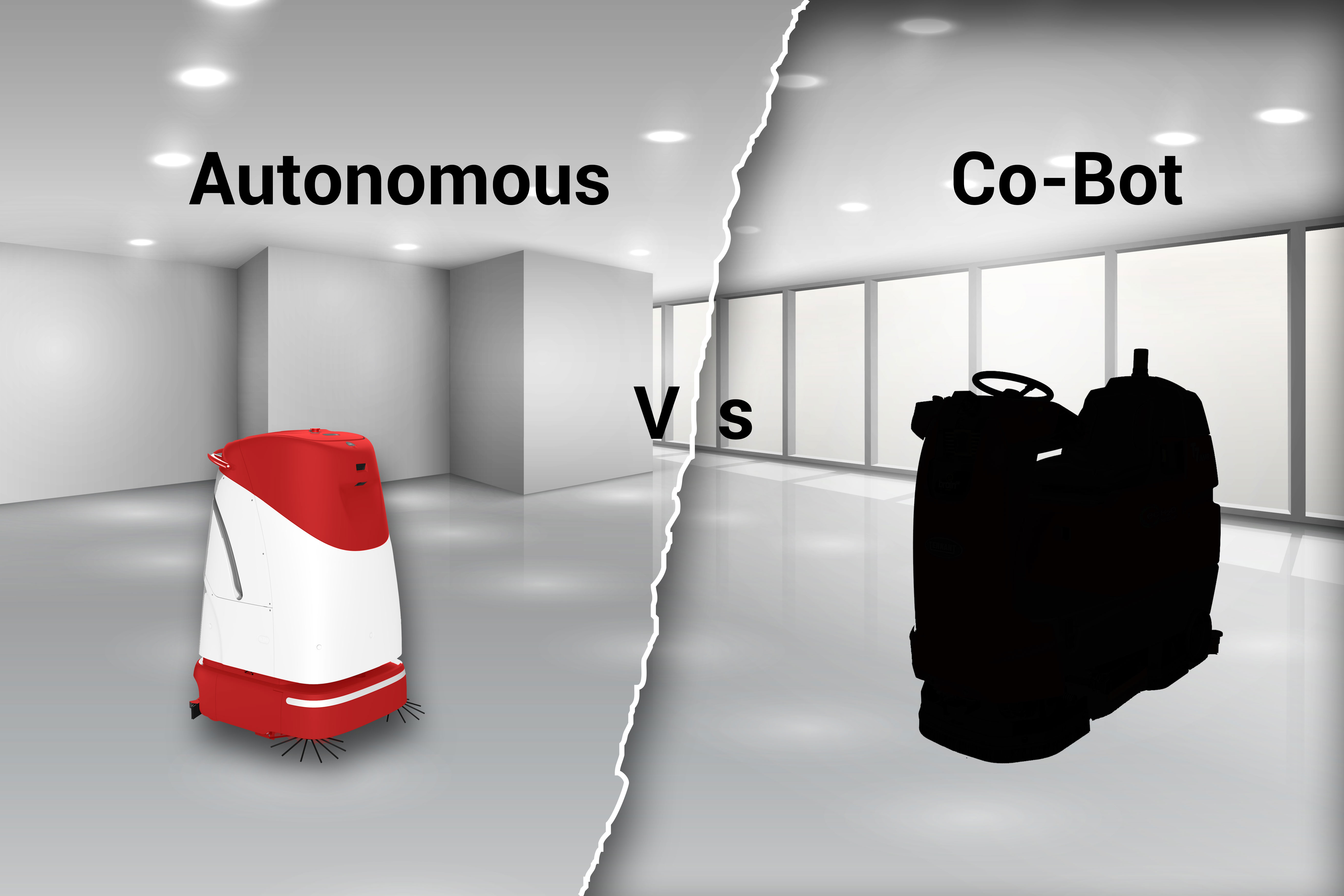Blog
Cobot vs Fully Autonomous
Back to Blog(s)
January 15 2024
January 15 2024
Why the Difference Matters When it Comes to Cleaning

Since their emergence on the scene some twelve years ago, commercial and industrial floor scrubbers capable of automated cleaning have been slowly changing the face of Jan-San and facilities management. Walmart was one of the first highly visible companies to incorporate robotic floor scrubbers at scale, back in 2018. Given the relative infancy of robotic floor cleaning development at the time, the units chosen for the stores’ fleet were what can best be described as “cobots.” Formerly ride-on and walk-behind scrubbers that had been retrofitted to perform certain tasks autonomously, these units differ from the latest generation of fully autonomous floor cleaners and scrubbers in several important ways.
With significant advancements being made over a short period of time, it’s worth discussing the differences between cobot and fully autonomous floor cleaning units.
Cobot Floor Scrubbers
The term “cobot” dates back to 2000, when a Northwestern University postdoc proposed the name as part of a lab competition. Short for “collaborative robot,” a cobot is defined as a robot intended for direct physical interaction with a human user, within a shared workspace. In more recent years, robotics companies and the media have used the term to apply to any robot whose given tasks find it operating alongside human workers. And indeed, many fully autonomous service robots can fall under this generic cobot definition, used as they are within high-traffic human spaces like hospitals, schools, restaurants and hotels.
For the purposes of this discussion, a cobot-type floor scrubber is one that not only works alongside humans, but requires human intervention in multiple aspects of its operation. For instance, a human may need to start the unit; physically push the unit to the cleaning location; input cleaning duration and path each cycle; empty water tanks and refuse bins; replenish cleaning solutions; and plug the unit back in to recharge. Therefore, while the cobot unit may perform the actual sweeping/scrubbing, human involvement in the process is still fairly high.
While this type of interaction does save some physical labor and strain (as does a ride-on or walk-behind scrubber), it doesn’t truly release custodial staff from the burden of floor cleaning to the same extent as a fully autonomous solution. The robot:human work ratio in this scenario is about 50:50. It’s also a big reason why these types of robotic scrubbers tend to cost less than their newer, fully autonomous counterparts. The holistic autonomous functionality simply isn’t there to the same degree.
And, as mentioned above, many cobot units began life as traditional ride-on or walk-behind machines that were then retrofitted with an operating system that conveyed some degree of autonomous operation. Also known as “kit” units, these were the first wave of robotic floor scrubbers to gain popularity. But unlike newer purpose-built autonomous units, the functionality is more limited, the human demands are higher, and the units themselves tend to be larger, bulkier, and less applicable to dynamic, busy human spaces.
Fully Autonomous
In contrast to cobot sweepers and scrubbers, fully autonomous units require very little in the way of human operation or intervention. Built from the ground up specifically for autonomous operation, most of these machines (like the CC1, CC3 and CC5) are equipped with an advanced robot operating system (ROS) which is native to the robot rather than retrofitted.
Due to their advanced ROS and additional software integrations, fully autonomous units can “wake” themselves up, go to the assigned cleaning location, perform cleaning tasks and return “home” or to a new location—all based on predetermined workflows. They can also be activated and sent to perform tasks on an ad-hoc basis, as needs arise. These autonomous robots are also able to self monitor and maintain homeostasis, returning to their self-charging dock as needed.
That said, even fully autonomous units vary in their true hands-off approach. Many autonomous sweepers and scrubbers still require a custodian’s help to empty dirty water tanks and refuse bins, and replenish with fresh water/cleaning solution. Very few on the market are able to perform these labor-saving self maintenance tasks autonomously, which cuts down the overall efficiency of the units. Luckily, all three floor cleaning units in Pringle Robotics’ lineup are equipped with this additional functionality, making them some of the most truly autonomous floor cleaning robots on the market.
Connectivity Counts
One of the great promises of the fully autonomous floor cleaning robot is the immense labor savings realized by facilities that adopt this technology. This is due, not only to the physical work performed by the robots, but also to the high level tracking, monitoring and workflow refinement made possible by new cloud-based asset management systems like Pringle NOC.
The Pringle Network Operations Console (PringleNOC) allows facility custodial teams to monitor, track, and view detailed task reports from all connected robots. This gives facility managers vital insight into actual robot usage, robot health and workflow efficiency, ensuring absolute transparency in facility cleaning operations. And in the very near future, fully autonomous robots will be able to be started, stopped, and assigned tasks remotely through cloud-based systems like NOC. It’s the next step in robot and asset fleet management, and a revolutionary innovation in data accessibility and technology integration for the Jan-San industry.
Freeing People to Do More
While even meager levels of automation can help relieve burden and repetitive physical strain from human workers, reaching the inflection point at which “helpful” transitions to “heroic” requires automation of tasks to the highest degree possible. New, fully autonomous cleaning robots deliver on this promise in ways their predecessors can’t match. Facilities that adopt this new technology reap the benefits, not only in cleanliness, but in employee retention and morale, data transparency, and ROI.
Interested in learning more about what fully autonomous floor cleaning robots can do for your facility? Get in touch with our team of experts!
Leave a comment below...